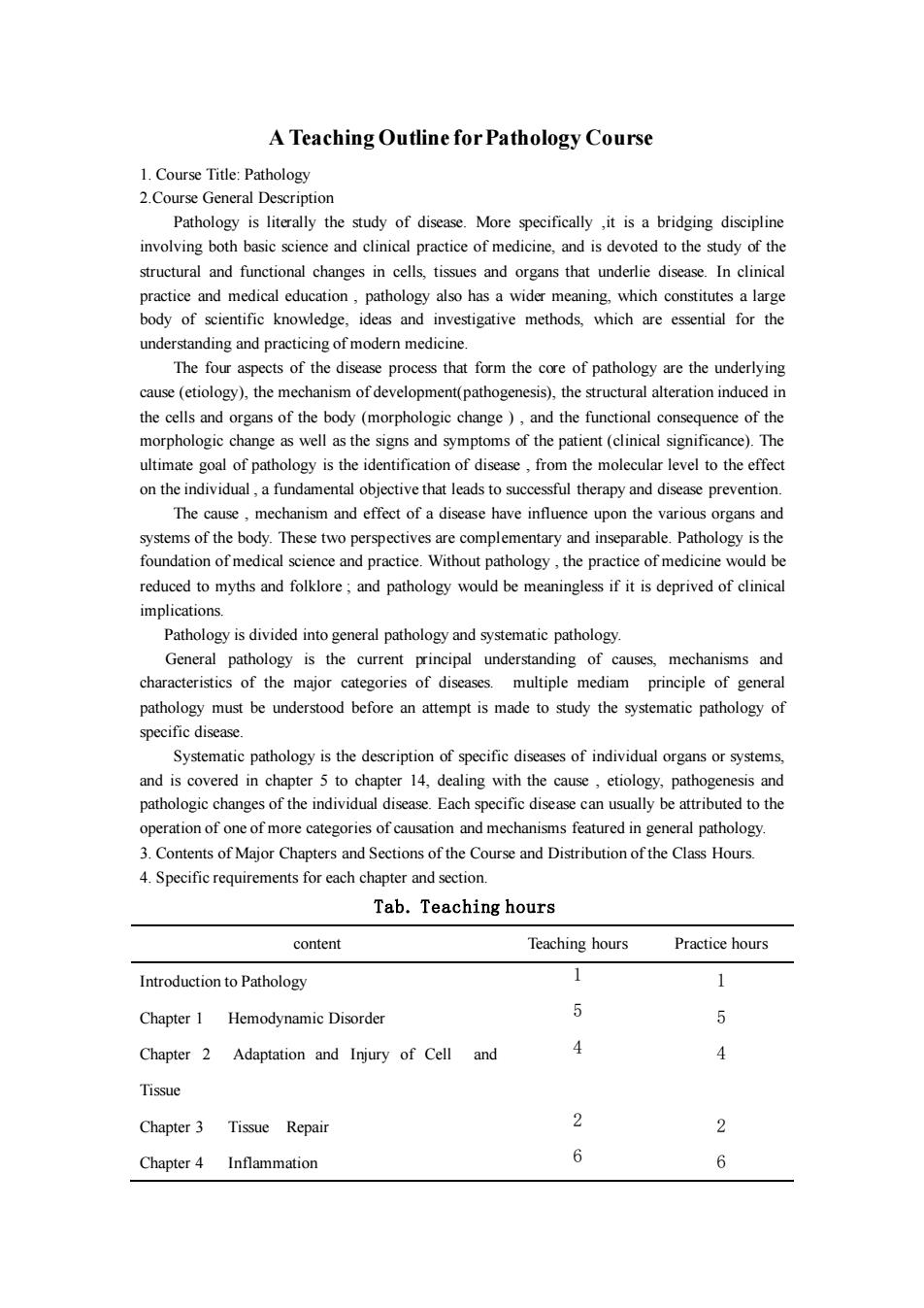
A Teaching Outline for Pathology Course 1.Course Title:Pathology 2.Course General Description Pathology is literally the study of disease.More specifically ,it is a bridging discipline involving both basie science and clinical practice of medicine,and is devoted to the study of the structural and functional changes in cells,tissues and organs that underlie discase.In clinical and medical ducation pathology also hasawide ine wloleed me understanding and practicing of modern medicine. The four aspects of the disease process that form the core of pathology are the underlying cause(etiology),the mechanism of development(pathogenesis),the structural alteration induced in organs of the body (morphologic change and the functionalo ehnse elthend mth tient (lnie cquence of the significance).The ultimate goal of pathology is the identification of disease,from the molecular level to the effect on the individual,a fundamental objective that leads to successful therapy and disease prevention. The cause.mechanism and effect of a disease have influence upon the various organs and ectivesare and inseparable.Pathology is the end practice.Without pathologythe pra ctice of medi ould be reduced to myths and folklore and pathology would be meaningless if it is deprived of clinical implications. Pathology is divided into general pathology and systematic pathology ra pathology is the cuent principal undersadno mechanisms and chara of the diseases multip mediam principle of genera pathology must be understood before an attempt is made to study the systematic pathology of specific disease. Systematic pathology is the description of specific diseases of individual organs or systems, and is covered in chapter 5 to chapter 14.dealing with the cause.etiology.pathogenesis and pathologic changes of the operation of one of more of and mechanisms featured in general pathology 3.Contents of Major Chapters and Sections of the Course and Distribution of the Class Hours. 4.Specific requirements for each chapter and section. Tab.Teaching hours content Teaching hours Practice hours Introduction to Patholog 1 Chapter 1 Hemodynamic Disorder 5 Chapter 2 Adaptation and Injury of Cell and 4 Tissue Chapter 3 Tissue Repai Chapter 4 Inflammation 6
A Teaching Outline for Pathology Course 1. Course Title: Pathology 2.Course General Description Pathology is literally the study of disease. More specifically ,it is a bridging discipline involving both basic science and clinical practice of medicine, and is devoted to the study of the structural and functional changes in cells, tissues and organs that underlie disease. In clinical practice and medical education , pathology also has a wider meaning, which constitutes a large body of scientific knowledge, ideas and investigative methods, which are essential for the understanding and practicing of modern medicine. The four aspects of the disease process that form the core of pathology are the underlying cause (etiology), the mechanism of development(pathogenesis), the structural alteration induced in the cells and organs of the body (morphologic change ) , and the functional consequence of the morphologic change as well as the signs and symptoms of the patient (clinical significance). The ultimate goal of pathology is the identification of disease , from the molecular level to the effect on the individual , a fundamental objective that leads to successful therapy and disease prevention. The cause , mechanism and effect of a disease have influence upon the various organs and systems of the body. These two perspectives are complementary and inseparable. Pathology is the foundation of medical science and practice. Without pathology , the practice of medicine would be reduced to myths and folklore ; and pathology would be meaningless if it is deprived of clinical implications. Pathology is divided into general pathology and systematic pathology. General pathology is the current principal understanding of causes, mechanisms and characteristics of the major categories of diseases. multiple mediam principle of general pathology must be understood before an attempt is made to study the systematic pathology of specific disease. Systematic pathology is the description of specific diseases of individual organs or systems, and is covered in chapter 5 to chapter 14, dealing with the cause , etiology, pathogenesis and pathologic changes of the individual disease. Each specific disease can usually be attributed to the operation of one of more categories of causation and mechanisms featured in general pathology. 3. Contents of Major Chapters and Sections of the Course and Distribution of the Class Hours. 4. Specific requirements for each chapter and section. Tab. Teaching hours content Teaching hours Practice hours Introduction to Pathology 1 1 Chapter 1 Hemodynamic Disorder 5 5 Chapter 2 Adaptation and Injury of Cell and Tissue 4 4 Chapter 3 Tissue Repair 2 2 Chapter 4 Inflammation 6 6
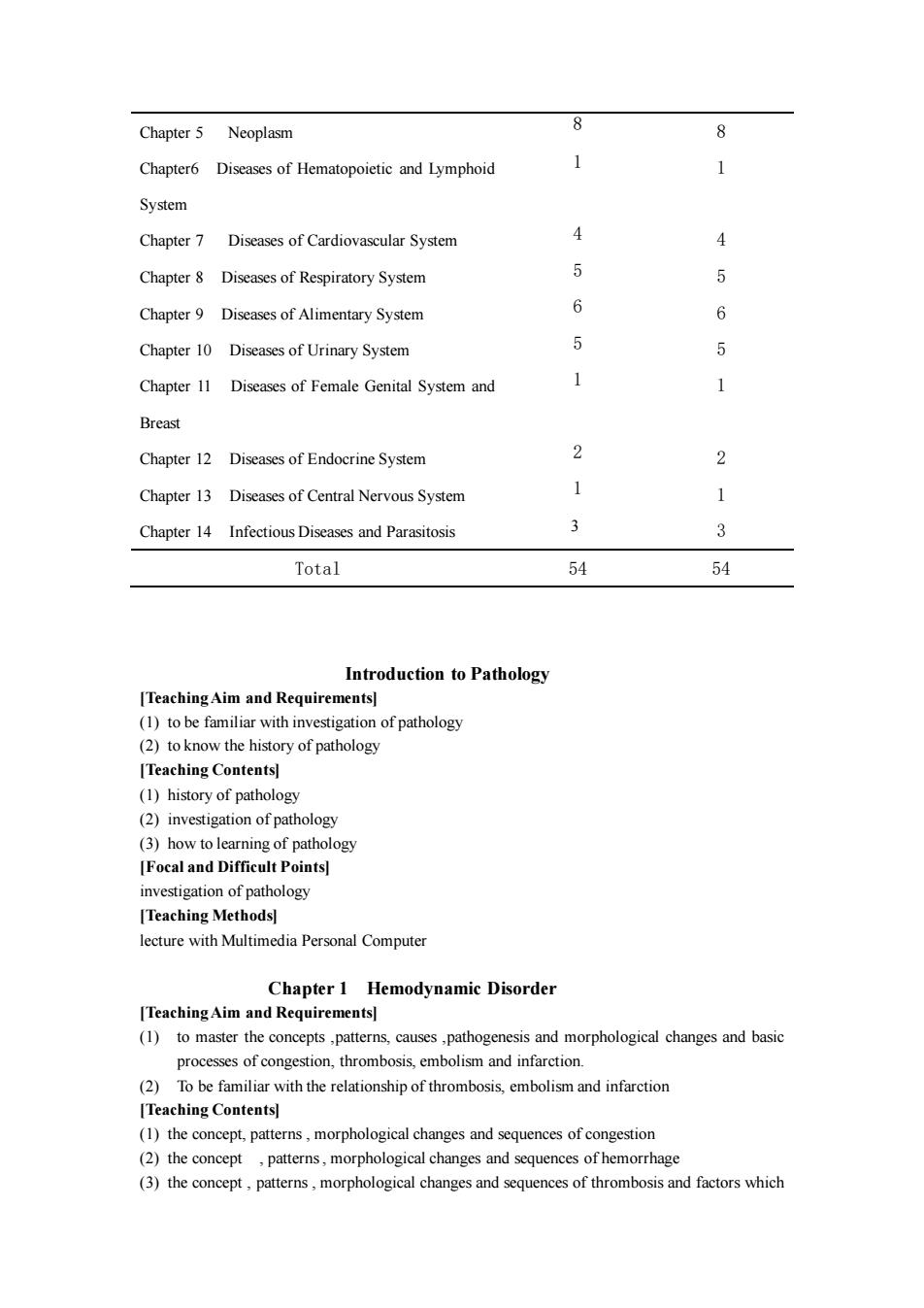
8 Chapter 5 Neoplasm 8 Chapter6 Diseases of Hematopoietic and Lymphoid System Chapter 7 Diseases of Cardiovascular System 4 Chapter 8 Diseases of Respiratory System 5 Chapter9 Diseases of Alimentary System 6 6 Chapter 10 Diseases of Urinary System 5 Chapter 11 Diseases of Female Genital System and 1 Breast Chapter 12 Diseases of Endocrine System 2 Chapter 13 Diseases of Central Nervous System Chapter 14 Infectious Diseases and Parasitosis 3 3 Total 54 54 Introduction to Pathology [Teaching Aim and Requirementsl (1)to be familiar with investigation of pathology (2)to know the history of pathology [Teaching Contents] (1)history of pathology (2)investigation of pathology (3)how to learning of pathology Focal and Difficult Points] investigation of pathology [Teaching Methods] lecture with Multimedia Personal Computer Chapter 1 Hemodynamic Disorder [Teaching Aim and Requirements] (1)to master the concepts,pattern causespathogenesis and morphological hanges and basic processes of congestion,thrombosis,embolism and infarction. (2)To be familiar with the relationship of thrombosis.embolism and infarction [Teaching Contents] (1)the concept.patterns.morphological changes and sequences of congestion (2)the concept .patterns,m logical ch anges and s (3)the hangesand of thrombosis and factors which
Chapter 5 Neoplasm 8 8 Chapter6 Diseases of Hematopoietic and Lymphoid System 1 1 Chapter 7 Diseases of Cardiovascular System 4 4 Chapter 8 Diseases of Respiratory System 5 5 Chapter 9 Diseases of Alimentary System 6 6 Chapter 10 Diseases of Urinary System 5 5 Chapter 11 Diseases of Female Genital System and Breast 1 1 Chapter 12 Diseases of Endocrine System 2 2 Chapter 13 Diseases of Central Nervous System 1 1 Chapter 14 Infectious Diseases and Parasitosis 3 3 Total 54 54 Introduction to Pathology [Teaching Aim and Requirements] (1) to be familiar with investigation of pathology (2) to know the history of pathology [Teaching Contents] (1) history of pathology (2) investigation of pathology (3) how to learning of pathology [Focal and Difficult Points] investigation of pathology [Teaching Methods] lecture with Multimedia Personal Computer Chapter 1 Hemodynamic Disorder [Teaching Aim and Requirements] (1) to master the concepts ,patterns, causes ,pathogenesis and morphological changes and basic processes of congestion, thrombosis, embolism and infarction. (2) To be familiar with the relationship of thrombosis, embolism and infarction [Teaching Contents] (1) the concept, patterns , morphological changes and sequences of congestion (2) the concept , patterns , morphological changes and sequences of hemorrhage (3) the concept , patterns , morphological changes and sequences of thrombosis and factors which
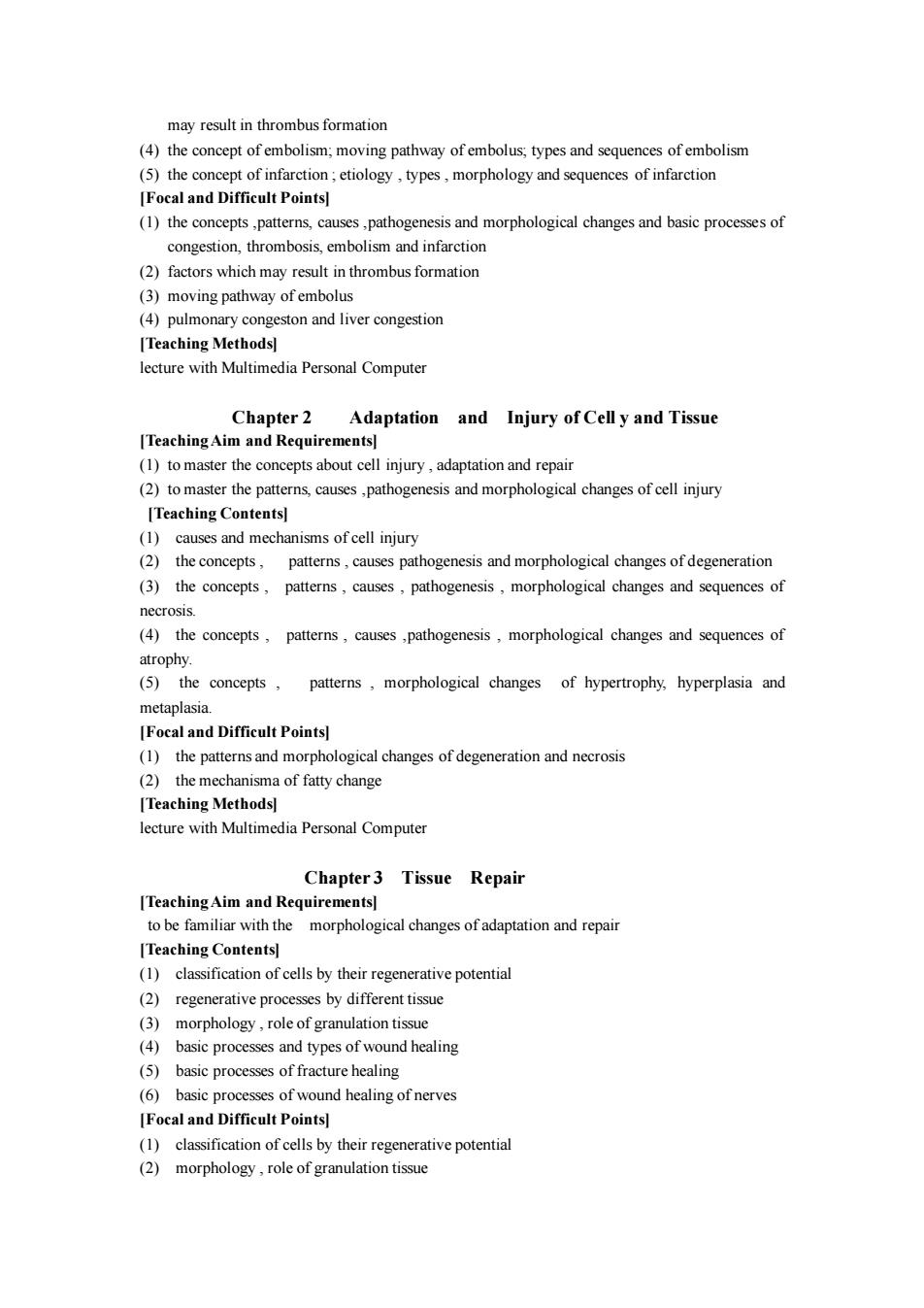
may result in thrombus formation (4)the of embolism moving pathway of embolus,types and of embolism Focal and Difficult Points (1)the concepts,patterns,causes,pathogenesis and morphological changes and basic processes of congestion,thrombosis,embolism and infaretion (2)factors which may result in thrombus formation (3)moving pathway ofembol (4)pulmonary congeston and liver congestion Teaching Methods lecture with Multimedia Personal Computer Chapter 2 Adaptation and Injury of Celly and Tissu Teaching Aim and Requirements (1)to master the concepts about cell injury,adaptation and repair (2)to master the patterns,causes,pathogenesis and morphological changes of cell injury ITeaching Contentsl (mechanisms of el injury (2)the concepts. patterns,causes pathogenesis and morphological changes of degeneration (3)the concepts,patterns,causes,pathogenesis,morphological changes and sequences of necrosis. (4)the concepts,patterns,causes,pathogenesis,morphological changes and sequences of atrophy. (5) the concepts, patterns.morphological changes of hypertrophy,hyperplasia and metaplasia Focal and Difficult Pointsl (1)the patterns and morphological changes of degeneration and necrosis (2)the mechanisma of fatty change [Teaching Methods] eture with Multimedia Personl Computer Chapter3 Tissue Repair ITeaching Aim and Reguirementsl to be familiar with the morphological changes of adaptation and repair [Teaching Contents] (1)classification of cells by their regenerative potential (2)regenerative processes by different tissue (3)morphology,role of granulation tissue (5)basic proc (6)basic proc ses of wound healing of nerves Focal and Difficult Points (1)classification of cells by their regenerative potential (2)morphology,role of granulation tissue
may result in thrombus formation (4) the concept of embolism; moving pathway of embolus; types and sequences of embolism (5) the concept of infarction ; etiology , types , morphology and sequences of infarction [Focal and Difficult Points] (1) the concepts ,patterns, causes ,pathogenesis and morphological changes and basic processes of congestion, thrombosis, embolism and infarction (2) factors which may result in thrombus formation (3) moving pathway of embolus (4) pulmonary congeston and liver congestion [Teaching Methods] lecture with Multimedia Personal Computer Chapter 2 Adaptation and Injury of Cell y and Tissue [Teaching Aim and Requirements] (1) to master the concepts about cell injury , adaptation and repair (2) to master the patterns, causes ,pathogenesis and morphological changes of cell injury [Teaching Contents] (1) causes and mechanisms of cell injury (2) the concepts , patterns , causes pathogenesis and morphological changes of degeneration (3) the concepts , patterns , causes , pathogenesis , morphological changes and sequences of necrosis. (4) the concepts , patterns , causes ,pathogenesis , morphological changes and sequences of atrophy. (5) the concepts , patterns , morphological changes of hypertrophy, hyperplasia and metaplasia. [Focal and Difficult Points] (1) the patterns and morphological changes of degeneration and necrosis (2) the mechanisma of fatty change [Teaching Methods] lecture with Multimedia Personal Computer Chapter 3 Tissue Repair [Teaching Aim and Requirements] to be familiar with the morphological changes of adaptation and repair [Teaching Contents] (1) classification of cells by their regenerative potential (2) regenerative processes by different tissue (3) morphology , role of granulation tissue (4) basic processes and types of wound healing (5) basic processes of fracture healing (6) basic processes of wound healing of nerves [Focal and Difficult Points] (1) classification of cells by their regenerative potential (2) morphology , role of granulation tissue
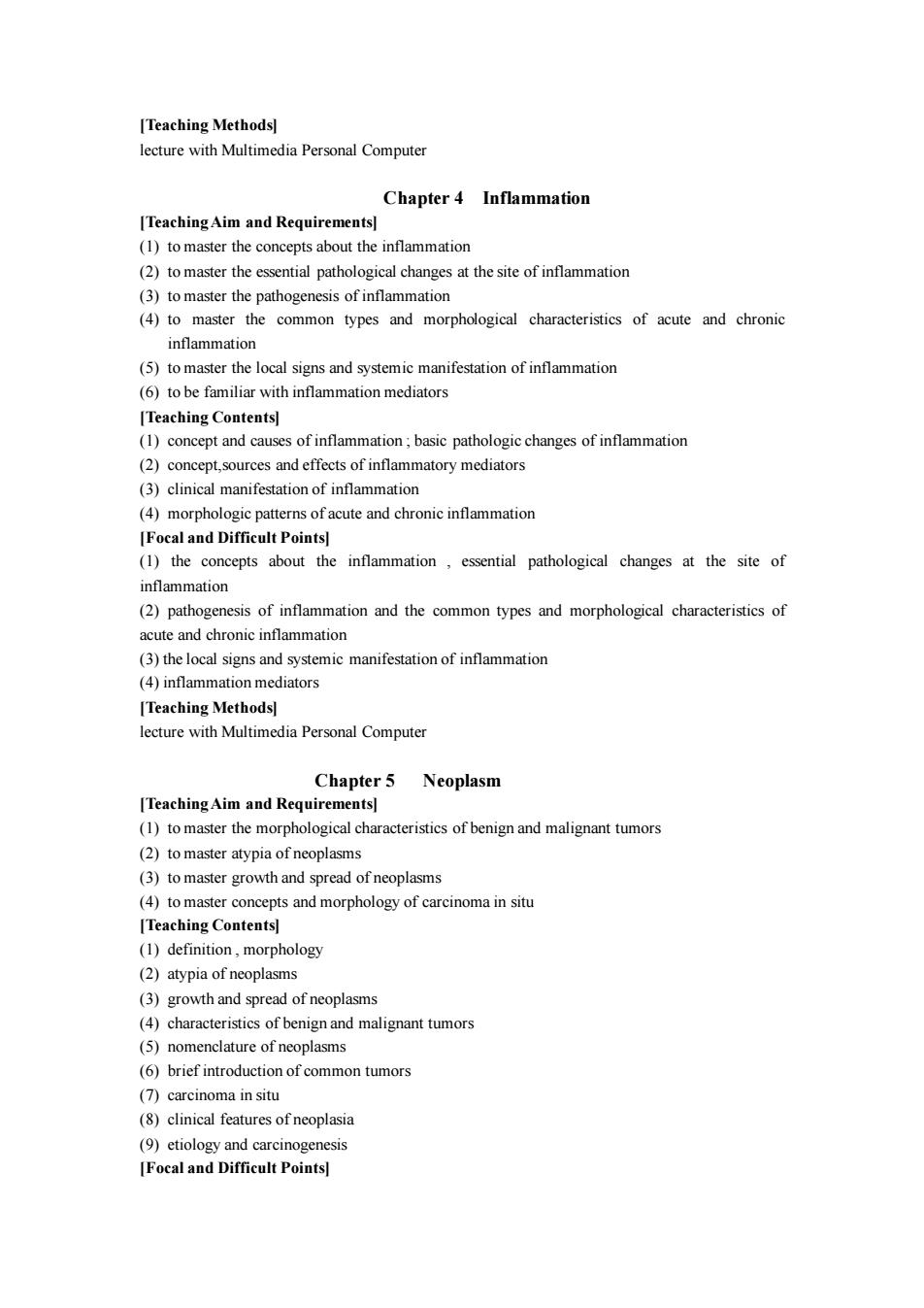
ITeaching Methodsl lecture with Multimedia Personal Computer Chapter 4 Inflammation [Teaching Aim and Requirements] (1)to master the concepts about the inflammation (2)tomaster the pathological changes thesite of (3)tomaster the pathogenesis of inflammation (4)to master the common types and morphological characteristics of acute and chronic inflammation (5)to master the local signs and systemic manifestation of inflammation (6)tobe familiar with infammation mediators [Teaching Contents (1)concept and causes of inflammation;basic pathologic changes of inflammation (2)coneept sources and effects of inflammatory mediators (3)clinical manifestation of inflammation (4)morphologic patterns ofacute and chronic inflammation Focal and Difficult Points (1)the concepts about the inflammation,essential pathological changes at the site of inflammation (2)pathogenesis of inflammation and the common types and morphological characteristics of acute and chronic inflammation (3)the local signs and systemic manifestation of infammation (4)inflamm [Teaching Methods] lecture with Multimedia Personal Computer Chapter 5 Neoplasm [Teaching Aim and Requ rements (1)to master the morphological characteristics of benign and malignant tumors (2)to master atypia of neoplasms (3)to master growth and spread of neoplasms (4)to master concepts and morphology of carcinoma in situ ITeaching contentsl (2)atypia of neoplasms (3)growth and spread of neoplasms (4)characteristics of benign and malignant tumor etion of common tumors (7)carcinoma in sitt (8)clinical features of neoplasia (9)etiology and carcinogenesis Focal and Difficult Points]
[Teaching Methods] lecture with Multimedia Personal Computer Chapter 4 Inflammation [Teaching Aim and Requirements] (1) to master the concepts about the inflammation (2) to master the essential pathological changes at the site of inflammation (3) to master the pathogenesis of inflammation (4) to master the common types and morphological characteristics of acute and chronic inflammation (5) to master the local signs and systemic manifestation of inflammation (6) to be familiar with inflammation mediators [Teaching Contents] (1) concept and causes of inflammation ; basic pathologic changes of inflammation (2) concept,sources and effects of inflammatory mediators (3) clinical manifestation of inflammation (4) morphologic patterns of acute and chronic inflammation [Focal and Difficult Points] (1) the concepts about the inflammation , essential pathological changes at the site of inflammation (2) pathogenesis of inflammation and the common types and morphological characteristics of acute and chronic inflammation (3) the local signs and systemic manifestation of inflammation (4) inflammation mediators [Teaching Methods] lecture with Multimedia Personal Computer Chapter 5 Neoplasm [Teaching Aim and Requirements] (1) to master the morphological characteristics of benign and malignant tumors (2) to master atypia of neoplasms (3) to master growth and spread of neoplasms (4) to master concepts and morphology of carcinoma in situ [Teaching Contents] (1) definition , morphology (2) atypia of neoplasms (3) growth and spread of neoplasms (4) characteristics of benign and malignant tumors (5) nomenclature of neoplasms (6) brief introduction of common tumors (7) carcinoma in situ (8) clinical features of neoplasia (9) etiology and carcinogenesis [Focal and Difficult Points]
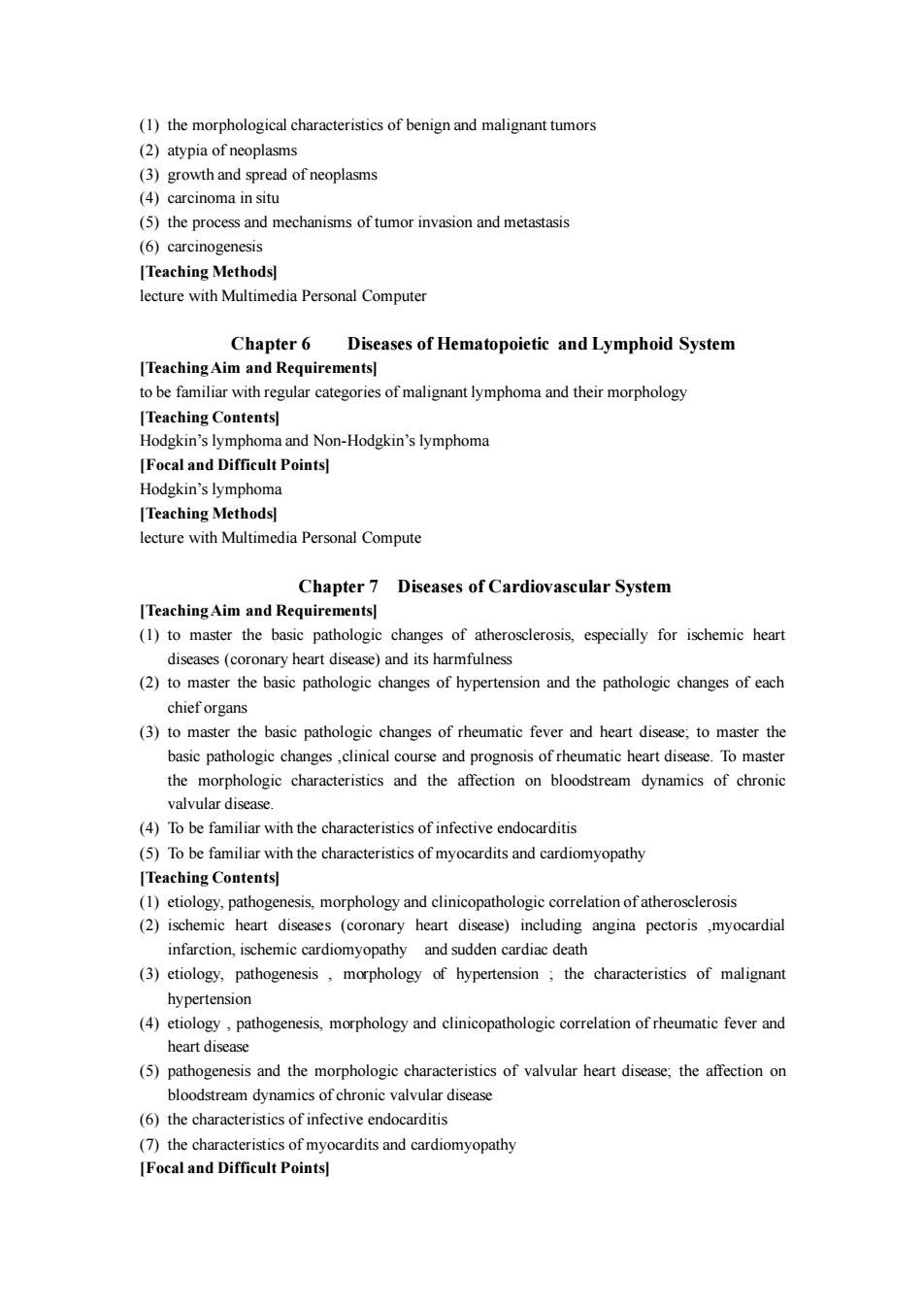
(1)the morphological characteristics of benign and malignant tumors of neoplasms (4)carcinoma in situ (5)the process and mechanisms of tumor invasion and metastasis (6)carcinogenesis [Teaching Methods] lecture with Multimedia Personal Computer Chapter 6 Diseases of Hematopoietic and Lvmphoid System [Teaching Aim and Requirements] to be familiar with regular categories of malignant lymphoma and their morphology Teaching Contents oma and Non-Hodgkin's lymphoma Focal and Difficult Points Hodgkin's lymphoma [Teaching Methodsl ecture with Multimedia Personal Compute Chapter 7 Diseases of Cardiovascular System ITeaching Aim and Requirementsl (1)to master the basic pathologic changes of atherosclerosis,especially for ischemic heart diseases (coronary heart disease)and its harmfuness (2)t naster the hasic ch anges of hypertension and the pathologic changes of each chief organs (3)to master the basic pathologic changes of rheumatic fever and heart disease;to master the basic pathologic changes,clinical course and prognosis of rheumatic heart disease.To master the morphologic characteristics and the affection on bloodstream dynamics of chronic valyular diseas (4)Tobe familiar with the characteristics of (5)To be familiar with the characteristics of myocardits and cardiomyopathy ITeaching Contentsl (1)etiology.pathogenesis.morphology and clinicopathologic correlation of atherosclerosis (2)ischemic heart diseases (coronary heart disease)including angina pectoris,myocardial and sudden cardiac de ()etiology,pathogenesis,morphology of hypertension;the characteristics of malignant hypertension (4)etiology,pathogenesis,morphology and clinicopathologic correlation of rheumatic fever and heart disease rphologic characteristics of valvular heartis the affection on (6)the characteristics of infective endocarditis (7)the characteristics of myocardits and cardiomyopathy [Focal and Difficult Points]
(1) the morphological characteristics of benign and malignant tumors (2) atypia of neoplasms (3) growth and spread of neoplasms (4) carcinoma in situ (5) the process and mechanisms of tumor invasion and metastasis (6) carcinogenesis [Teaching Methods] lecture with Multimedia Personal Computer Chapter 6 Diseases of Hematopoietic and Lymphoid System [Teaching Aim and Requirements] to be familiar with regular categories of malignant lymphoma and their morphology [Teaching Contents] Hodgkin’s lymphoma and Non-Hodgkin’s lymphoma [Focal and Difficult Points] Hodgkin’s lymphoma [Teaching Methods] lecture with Multimedia Personal Compute Chapter 7 Diseases of Cardiovascular System [Teaching Aim and Requirements] (1) to master the basic pathologic changes of atherosclerosis, especially for ischemic heart diseases (coronary heart disease) and its harmfulness (2) to master the basic pathologic changes of hypertension and the pathologic changes of each chief organs (3) to master the basic pathologic changes of rheumatic fever and heart disease; to master the basic pathologic changes ,clinical course and prognosis of rheumatic heart disease. To master the morphologic characteristics and the affection on bloodstream dynamics of chronic valvular disease. (4) To be familiar with the characteristics of infective endocarditis (5) To be familiar with the characteristics of myocardits and cardiomyopathy [Teaching Contents] (1) etiology, pathogenesis, morphology and clinicopathologic correlation of atherosclerosis (2) ischemic heart diseases (coronary heart disease) including angina pectoris ,myocardial infarction, ischemic cardiomyopathy and sudden cardiac death (3) etiology, pathogenesis , morphology of hypertension ; the characteristics of malignant hypertension (4) etiology , pathogenesis, morphology and clinicopathologic correlation of rheumatic fever and heart disease (5) pathogenesis and the morphologic characteristics of valvular heart disease; the affection on bloodstream dynamics of chronic valvular disease (6) the characteristics of infective endocarditis (7) the characteristics of myocardits and cardiomyopathy [Focal and Difficult Points]